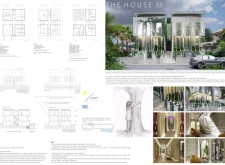5 key facts about this project
### Project Overview
Located in Barcelona, Spain, "The House 33" is designed to enhance the relationship between living spaces and the environment while balancing openness and privacy. The architectural intent focuses on creating versatile areas that cater to communal activities and individual retreats. Integrating traditional Spanish design elements within a contemporary framework, the project reflects the local architectural language while adapting it to modern living.
### Spatial Strategy
The spatial organization of "The House 33" emphasizes a thoughtful arrangement that prioritizes user experience. Open living areas facilitate interaction, combining functions such as dining, cooking, and relaxing into a cohesive environment. Private quarters, including bedrooms and bathrooms, are strategically placed to ensure privacy while maintaining views of the surrounding landscape. Outdoor spaces, including balconies and terraces, encourage engagement with the external environment and contribute to the overall flow of the design.
### Materiality and Sustainability
The material selection in "The House 33" significantly influences its character and sustainability initiatives. Concrete serves as the primary structural element, providing durability and a minimalist aesthetic, while extensive use of glass enhances transparency, connecting interior and exterior spaces. Metal contributes to the modern design, used for structural frameworks and decorative details. Wood is incorporated for interior finishes, adding warmth and texture, which balances the more austere elements of concrete and glass.
Sustainability is a core component of the design, featuring a rainwater collection system that utilizes the building's columns for effective water management. The architecture promotes natural ventilation to improve indoor air quality without relying heavily on mechanical cooling systems. Spatial organization maximizes natural light, reducing the dependence on artificial lighting and enhancing energy efficiency. Additionally, unique features such as thermal technologies and playful design elements reflect a commitment to both cultural resonance and environmental stewardship.






















































